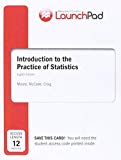
Concept explainers
(a)
Section 1:
To find: The average and standard deviation of
(a)
Section 1:
Answer to Problem 7UYK
Solution: The sampling distribution
Explanation of Solution
Calculation: According to the central limit theorem, when a large sample n is selected from a population, with population average
Standard deviation of the sampling distribution
Section 2:
To find: The average and standard deviation of
Section 2:
Answer to Problem 7UYK
Solution: The sampling distribution
Explanation of Solution
Calculation: According to the central limit theorem, when a large sample n is selected from a population, with population average
Standard deviation of the sampling distribution
Section 3:
To find: The average and standard deviation of
Section 3:
Answer to Problem 7UYK
Solution: The sampling distribution
Explanation of Solution
Calculation: According to the central limit theorem, when a large sample n is selected from a population, with population average
Standard deviation of the sampling distribution
(b)
Section 1:
To find: The population distribution by using the Central Limit Theorem Applet.
(b)
Section 1:
Answer to Problem 7UYK
Solution: The distribution of the histogram has an average of 4.963 with standard deviation 2.019.
Explanation of Solution
Calculation: To obtain the population distribution by using the “Central Limit Theorem Applet,” follow the below steps:
Step 1: Go to “Central Limit Theorem Applet” on the website. The screenshot is shown below:
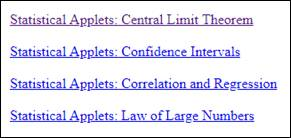
Step 2: Go to Choose distribution and select “Uniform(0,10).” The screenshot is shown below:
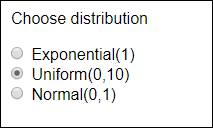
Step 3: Go to
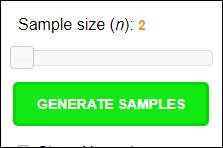
The obtained result is shown below:
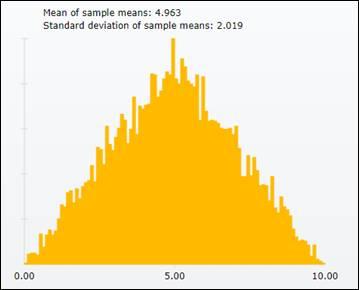
Interpretation: The distribution of the histogram has an average of 4.963 with standard deviation 2.019. All the values are near to the values that is calculated in part (a).
Section 2:
To find: The population distribution by using the Central Limit Theorem Applet.
Section 2:
Answer to Problem 7UYK
Solution: The distribution of the histogram has an average of 5.016 with standard deviation 0.915.
Explanation of Solution
Calculation: To obtain the population distribution by using the “Central Limit Theorem Applet,” follow the below steps:
Step 1: Go to “Central Limit Theorem Applet” on the website. The screenshot is shown below:

Step 2: Go to Choose distribution and select “Uniform(0,10).” The screenshot is shown below:

Step 3: Go to Sample size and specify n as “
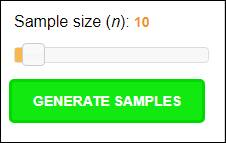
The obtained result is shown below:
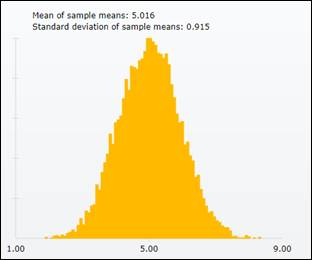
Interpretation: The distribution of the histogram has an average of 5.016 with standard deviation 0.915. All the values are near to the values that are calculated in part (a).
Section 3:
To find: The population distribution by using the Central Limit Theorem Applet.
Section 3:
Answer to Problem 7UYK
Solution: The distribution of the histogram has an average of 5.005 with standard deviation 0.575.
Explanation of Solution
Calculation: To obtain the population distribution by using the “Central Limit Theorem Applet,” follow the below steps:
Step 1: Go to “Central Limit Theorem Applet” on the website. The screenshot is shown below:

Step 2: Go to Choose distribution and select “Uniform(0,10).” The screenshot is shown below:

Step3: Go to Sample size and specify n as “
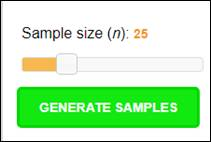
The obtained result is shown below:
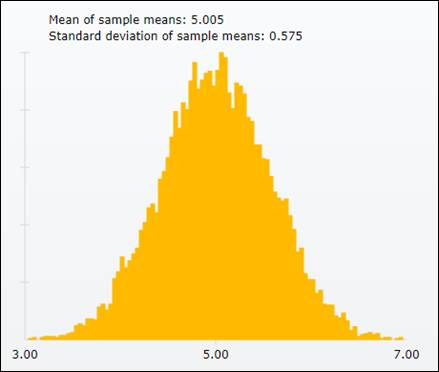
Interpretation: The distribution of the histogram has an average of 5.005 with standard deviation 0.575. All the values are near to the values that are calculated in part (a).
(c)
Section 1:
To find: The shape of the histogram and compare it with the normal plot.
(c)
Section 1:
Answer to Problem 7UYK
Solution: The shape of the distribution has bell-shaped curve. The shape of the histogram is close to the normal curve.
Explanation of Solution
Calculation: To compare the obtained histogram with the normal curve, follow the below steps:
Step 1: Go to “Central Limit Theorem Applet” on the website. The screenshot is shown below:
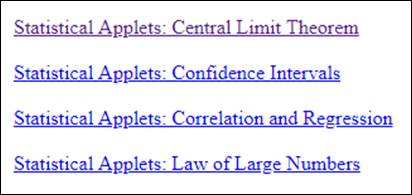
Step 2: Go to Choose distribution and select “Uniform(0,10).” The screenshot is shown below:
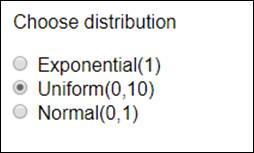
Step 3: Go to Sample size and specify n as “
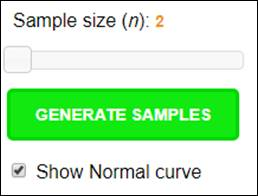
The obtained result is shown below:
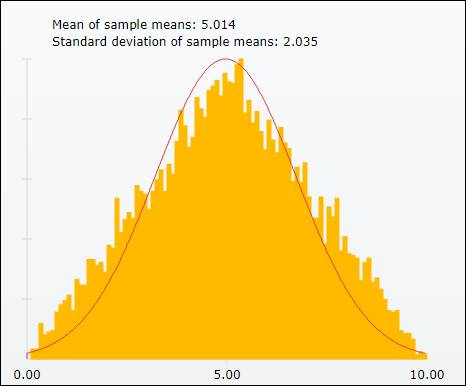
Interpretation: The obtained histogram is
Section 2:
To find: The shape of the histogram and compare it with the normal plot.
Section 2:
Answer to Problem 7UYK
Solution: The shape of the distribution has bell-shaped curve. The shape of the histogram is close to the normal curve.
Explanation of Solution
Calculation: To compare the obtained histogram with the normal curve, follow the steps below:
Step 1: Go to “Central Limit Theorem Applet” on the website. The screenshot is shown below:
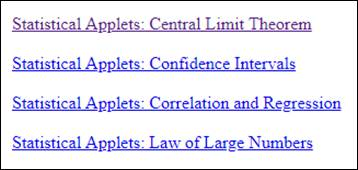
Step 2: Go to Choose distribution and select “Uniform(0,10).” The screenshot is shown below:
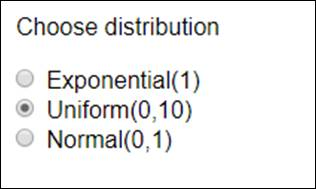
Step 3: Go to Sample size and specify n as “
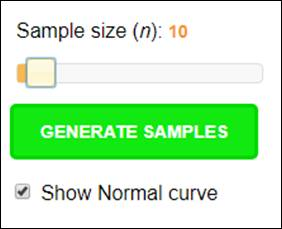
The obtained result is shown below:
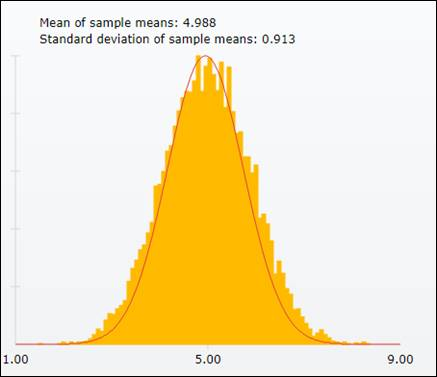
Interpretation: The obtained histogram is normally distributed with bell-shaped curve. It can be concluded that the shape of the histogram is close to the normal curve.
Section 3:
To find: The shape of the histogram and compare it with the normal plot.
Section 3:
Answer to Problem 7UYK
Solution: The shape of the distribution is bell-shaped curve. The shape of the histogram is close to the normal curve.
Explanation of Solution
Calculation: To compare the obtained histogram with the normal curve, follow the below steps:
Step 1: Go to “Central Limit Theorem Applet” on the website. The screenshot is shown below:

Step 2: Go to Choose distribution and select “Uniform(0,10).” The screenshot is shown below:

Step 3: Go to Sample size and specify n as “

The obtained result is shown below:

Interpretation: The obtained histogram is normally distributed with bell-shaped curve. It can be concluded that the shape of the histogram is close to the normal curve.
(d)
The required sample size.
(d)
Answer to Problem 7UYK
Solution: The sample size should be 25.
Explanation of Solution
Want to see more full solutions like this?
Chapter 5 Solutions
LaunchPad for Moore's Introduction to the Practice of Statistics (12 month access)
- For a binary asymmetric channel with Py|X(0|1) = 0.1 and Py|X(1|0) = 0.2; PX(0) = 0.4 isthe probability of a bit of “0” being transmitted. X is the transmitted digit, and Y is the received digit.a. Find the values of Py(0) and Py(1).b. What is the probability that only 0s will be received for a sequence of 10 digits transmitted?c. What is the probability that 8 1s and 2 0s will be received for the same sequence of 10 digits?d. What is the probability that at least 5 0s will be received for the same sequence of 10 digits?arrow_forwardV2 360 Step down + I₁ = I2 10KVA 120V 10KVA 1₂ = 360-120 or 2nd Ratio's V₂ m 120 Ratio= 360 √2 H I2 I, + I2 120arrow_forwardQ2. [20 points] An amplitude X of a Gaussian signal x(t) has a mean value of 2 and an RMS value of √(10), i.e. square root of 10. Determine the PDF of x(t).arrow_forward
- In a network with 12 links, one of the links has failed. The failed link is randomlylocated. An electrical engineer tests the links one by one until the failed link is found.a. What is the probability that the engineer will find the failed link in the first test?b. What is the probability that the engineer will find the failed link in five tests?Note: You should assume that for Part b, the five tests are done consecutively.arrow_forwardProblem 3. Pricing a multi-stock option the Margrabe formula The purpose of this problem is to price a swap option in a 2-stock model, similarly as what we did in the example in the lectures. We consider a two-dimensional Brownian motion given by W₁ = (W(¹), W(2)) on a probability space (Q, F,P). Two stock prices are modeled by the following equations: dX = dY₁ = X₁ (rdt+ rdt+0₁dW!) (²)), Y₁ (rdt+dW+0zdW!"), with Xo xo and Yo =yo. This corresponds to the multi-stock model studied in class, but with notation (X+, Y₁) instead of (S(1), S(2)). Given the model above, the measure P is already the risk-neutral measure (Both stocks have rate of return r). We write σ = 0₁+0%. We consider a swap option, which gives you the right, at time T, to exchange one share of X for one share of Y. That is, the option has payoff F=(Yr-XT). (a) We first assume that r = 0 (for questions (a)-(f)). Write an explicit expression for the process Xt. Reminder before proceeding to question (b): Girsanov's theorem…arrow_forwardProblem 1. Multi-stock model We consider a 2-stock model similar to the one studied in class. Namely, we consider = S(1) S(2) = S(¹) exp (σ1B(1) + (M1 - 0/1 ) S(²) exp (02B(2) + (H₂- M2 where (B(¹) ) +20 and (B(2) ) +≥o are two Brownian motions, with t≥0 Cov (B(¹), B(2)) = p min{t, s}. " The purpose of this problem is to prove that there indeed exists a 2-dimensional Brownian motion (W+)+20 (W(1), W(2))+20 such that = S(1) S(2) = = S(¹) exp (011W(¹) + (μ₁ - 01/1) t) 롱) S(²) exp (021W (1) + 022W(2) + (112 - 03/01/12) t). where σ11, 21, 22 are constants to be determined (as functions of σ1, σ2, p). Hint: The constants will follow the formulas developed in the lectures. (a) To show existence of (Ŵ+), first write the expression for both W. (¹) and W (2) functions of (B(1), B(²)). as (b) Using the formulas obtained in (a), show that the process (WA) is actually a 2- dimensional standard Brownian motion (i.e. show that each component is normal, with mean 0, variance t, and that their…arrow_forward
- The scores of 8 students on the midterm exam and final exam were as follows. Student Midterm Final Anderson 98 89 Bailey 88 74 Cruz 87 97 DeSana 85 79 Erickson 85 94 Francis 83 71 Gray 74 98 Harris 70 91 Find the value of the (Spearman's) rank correlation coefficient test statistic that would be used to test the claim of no correlation between midterm score and final exam score. Round your answer to 3 places after the decimal point, if necessary. Test statistic: rs =arrow_forwardBusiness discussarrow_forwardBusiness discussarrow_forward
 MATLAB: An Introduction with ApplicationsStatisticsISBN:9781119256830Author:Amos GilatPublisher:John Wiley & Sons Inc
MATLAB: An Introduction with ApplicationsStatisticsISBN:9781119256830Author:Amos GilatPublisher:John Wiley & Sons Inc Probability and Statistics for Engineering and th...StatisticsISBN:9781305251809Author:Jay L. DevorePublisher:Cengage Learning
Probability and Statistics for Engineering and th...StatisticsISBN:9781305251809Author:Jay L. DevorePublisher:Cengage Learning Statistics for The Behavioral Sciences (MindTap C...StatisticsISBN:9781305504912Author:Frederick J Gravetter, Larry B. WallnauPublisher:Cengage Learning
Statistics for The Behavioral Sciences (MindTap C...StatisticsISBN:9781305504912Author:Frederick J Gravetter, Larry B. WallnauPublisher:Cengage Learning Elementary Statistics: Picturing the World (7th E...StatisticsISBN:9780134683416Author:Ron Larson, Betsy FarberPublisher:PEARSON
Elementary Statistics: Picturing the World (7th E...StatisticsISBN:9780134683416Author:Ron Larson, Betsy FarberPublisher:PEARSON The Basic Practice of StatisticsStatisticsISBN:9781319042578Author:David S. Moore, William I. Notz, Michael A. FlignerPublisher:W. H. Freeman
The Basic Practice of StatisticsStatisticsISBN:9781319042578Author:David S. Moore, William I. Notz, Michael A. FlignerPublisher:W. H. Freeman Introduction to the Practice of StatisticsStatisticsISBN:9781319013387Author:David S. Moore, George P. McCabe, Bruce A. CraigPublisher:W. H. Freeman
Introduction to the Practice of StatisticsStatisticsISBN:9781319013387Author:David S. Moore, George P. McCabe, Bruce A. CraigPublisher:W. H. Freeman





